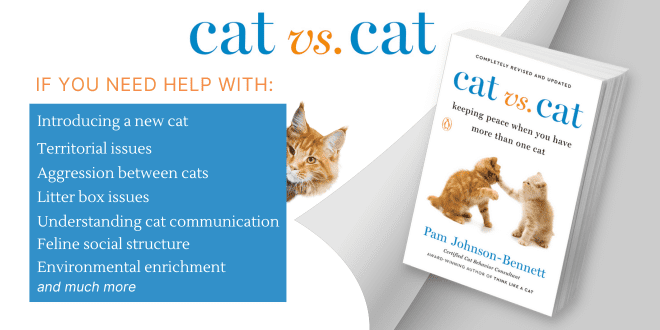
The key to keeping peace in a multicat household is to make sure there are enough resources and space for everyone. That doesn’t mean you have to move out of your current home and into a mansion, but it does mean there might need to be some tweaking done to the current environment. If each cat feels there are enough safe choices in terms of where to eat, sleep, eliminate, and play, life will be much happier. If they must all adhere to only one option, then that increases the chances of territorial disputes and also increases the stress level. Here are some quick reminders:
Proper Introduction of Cats
If you’re bringing home a new cat to your resident cat(s), make sure you start off on the right foot by doing a proper introduction. If you try to just put the cats in together to “work it out” you will set them up for failure. The right introduction involves making sure each cat feels secure and then when they meet, giving them a reason to like each other. It’s worth the time to go slowly and make the experience a positive one in order to set everyone up to succeed. Remember, the newcomer will be faced with not only unfamiliar cats, but also a totally unfamiliar environment. The resident cat will be facing the fact that there’s a feline intruder in the home and it could mean a threat to the security of resources as well as a threat to physical safety. Proper introductions can make all the difference in the success of this experience.
Once the cats have been properly introduced and are living together, it’s critical to maintain an environment that fosters security and safety.
Cat Feeding Stations
Don’t ask cats to share one community food bowl because that can become an invitation to intimidation if one cat bullies another in an attempt to be the first one (or only one) at the dinner plate. In many cases, the solution may just involve providing more than one bowl in the feeding area so each cat has an assigned spot. In other cases though, there may need to be additional feeding stations set up in other rooms. A cat who tries to nose others out of the food bowl can’t be in more than one place at one time. The feeding station should be a place where cats can eat in peace.
Litter Boxes
There should be more litter boxes than there are cats in the household. In addition to having an adequate number of boxes, place them in locations throughout the house and not in one room. If one cat feels nervous about passing through another cat’s area in order to eliminate, they may decide it’s just too stressful and could end up either eliminating on the carpet or retaining urine until the last possible second. Either of those options aren’t good ideas. Reduce stress by making sure boxes are located in areas where each cat feels most comfortable. Pay attention to social groups within your multicat household, or where cats have established their personal areas and that will provide clues as to the best litter box locations.
Scratching Posts
Provide multiple scratching posts in the home. Marking is one of the functions of scratching and some cats may not want to share a scratching post. You may also notice that each cat has a particular preference when it comes to where, when, or how they scratch. One cat may prefer horizontal scratching, one might do vertical scratching, another may like to scratch just after waking from a nap, etc. Place scratching posts in locations where the cats like to scratch and provide the type of post that will accommodate scratching preferences. In general, placement of scratching in socially significant areas is advised.
Hideaways and Beds for Cats
There might be one chair in your home that has become the favorite among the cats and there may be some bickering over who gets to sleep in it. Provide other cozy napping options to reduce disputes. Place A-frame beds, or donut beds on shelves or tucked away in corners for the cats who prefer to remain hidden while napping. Install padded window perches for the cats who like to nap in a sunny window. Observe your cats’ sleeping habits and location preferences so you can provide comfortable options for each one.
Some cats may like to remain somewhat hidden when entering a shared territory area. In that case, place cat tunnels around so a kitty can move through a room and feel invisible.
Feline-Friendly Vertical Territory
You can greatly increase your cats’ territory just by increasing the vertical space in your home. Cat trees, cat shelves, or window perches are easy and effective ways to help cats feel as if they have more physical territory than they actually do.
Multi-perched cat trees allow more than one cat to remain in close proximity to one another while still maintaining some degree of a pecking order. A cat tree may initially seem like an expensive investment but it will be a valuable and well-used piece of real estate inside your home. It may be the most stress-free way for a couple of cats to look out of the same window. It can also be a way that a higher-ranking displays status without having to resort to aggression. When shopping for a cat tree, choose one with large perches so cats feel comfortable without having legs hanging off the end. I recommend U-shaped perches so a cat can feel their back up against something which can increase a sense of security. Choose the type of tree based on the type of perches your cats have preferred. You may have a cat who prefers to lounge on a wide, flat perch.
Cat Playtime
Engage your cats in interactive playtime but don’t ask them to all compete for one toy or else there’s a strong probability that the game will turn from fun to intimidation. Instead, schedule individual interactive playtime with each cat each day. If you have a couple of cats who are very bonded and do play cooperatively without intimidation, then you can have them share the interactive toy as long as you’re careful to make sure each cat gets their turn.
Playtime with more than one cat can be done if you can hold an interactive toy in each hand so the cats don’t compete. If there’s another family member in the home who can help, that will obviously make group playtime much easier.
Monitor the Relationships Between the Cats
It’s up to you to watch the body language of your cats and monitor whether there is tension brewing. Use appropriate behavior techniques to diffuse tension and prevent the situation from escalating into something hostile. Keep your cats engaged in activities that distract them from picking on each other. Use environmental enrichment to keep cats happy and satisfied. Set up puzzle feeders, rotate toys and place them in interesting locations, engage in twice-daily interactive play sessions, and work on any issues before they become big problems.
Need More Information?
You can find the latest on managing a multicat household in the revised and updated edition of Pam’s best-selling book, Cat vs. Cat. Pam’s books are available at bookstores and online. We’ve included Amazon links here on our website.
If you have a question about your cat’s behavior or health, contact your veterinarian. This article is not intended as a medical diagnosis nor is it a replacement for your cat’s regular veterinary care. This article is for general information purposes only.

